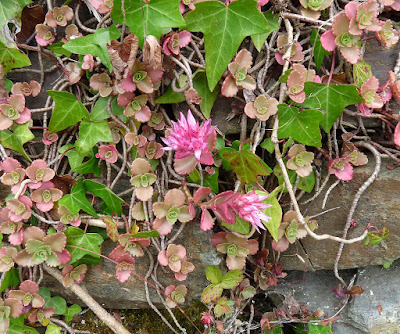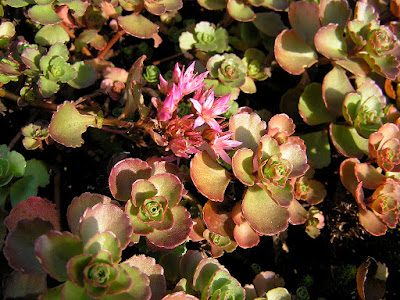Sedum spurium also called as Caucasian stonecrop, Two-row stonecrop, Phedimus spurius, is a species in the genus Sedum. It is usually located in poor thin soils, soilless media, at the edge of beds, or even in rock crevices. It is often found as a complementary plant that weaves in and around other plants or rambles over rockery, and mixes well with other perennials in raised planters, strawberry jars, edgings, rock gardens, and wall overhangs; less often found as a solid groundcover in the landscape.
Sedum spurium also called as Caucasian stonecrop, Two-row stonecrop, Phedimus spurius, is a species in the genus Sedum. It is usually located in poor thin soils, soilless media, at the edge of beds, or even in rock crevices. It is often found as a complementary plant that weaves in and around other plants or rambles over rockery, and mixes well with other perennials in raised planters, strawberry jars, edgings, rock gardens, and wall overhangs; less often found as a solid groundcover in the landscape.
IDENTIFY SEDUM SPURIUM - PHEDIMUS SPURIUS
Sedum spurium is native to the Caucasus and are widely naturalized in temperate W. Europe. It was introduced to cultivation in 1816. It is often grown in gardens and frequently escapes to form very persistent colonies; it was known from the wild by 1910.
It is a short herbaceous semi-evergreen groundcover maturing at about 4" tall in foliage and 6" tall when in flower - quickly spreading to form mats of dense stems and miniature foliage. The semi-evergreen succulent leaves are green, bronzed, red, crimson, or variegated (depending upon cultivar), usually abscising all but the most terminal leaves by late winter, with the remaining leaves staying bronzed into the following spring -opposite (or clustered at the stem apices), obovate (fan-shaped), crenate, and sessile to short-petioled.
Phedimus spurius blooms from the erect inflorescences occur above the foliage, with the vertical peduncles radiating flat-topped pedicels at the apex, bejeweled with many 5-petaled, star-like flowers. The red, pink, or pinkish-white flowers appears profusely for 2-4 weeks in June and July, especially on mature plants that are under a moderate amount of stress (or put another way, those that have it "good" in terms of soil, moisture, and nutrition tend to have predominantly lush vegetative growth rather than reproductive growth).
Several variants exist, primarily noted for foliage color and/or flower color:
- Sedum spurium 'Dragon's Blood' - the most popular cultivar, very vigorous, with deep mauve or dark pink inflorescences, noted for its greenish-bronzed to reddish-bronzed foliage throughout the summer, that turns to a deep and attractive burgundy in winter.
- Sedum spurium 'Fuldaglut’ or ‘Fireglow’, another dark burgundy Sedum spurium, is sometimes listed as ‘Dragon’s Blood’, although they are two distinct plants.
- Sedum spurium 'Red Carpet' - reddish foliage throughout the growing season, becoming a deep crimson in autumn and winter, rarely having deep carmine flowers; not as vigorous as most other greenor bronze-foliaged cultivars.
- Sedum spurium 'Tricolor' (also known as 'Variegatum') - foliage is a combination of faded jade green, white, and pink; this cultivar is weak, spreads slowly, is not dependably winter hardy, and rarely flowers. This variety is attractive both as a single specimen and as a large grouping, where it will paint a miniature revival of the pointillist school of post-impressionism.
- Sedum spurium ‘Voodoo’ is touted as the darkest burgundy of the Sedum spurium varieties. Deep burgundy leaves are topped with bright pink blooms from late spring through midsummer. Plants look striking paired with lime green succulents.
- Sedum spurium ‘John Creech’ has bright green leaves topped with mauve purple flowers in summer.
- Sedum spurium 'Coccineum' (also know as 'Purple Carpet') has bronze-tipped green leaves turn rusty red in chilly autumns.
- Sedum spurium "Album Superbum" has small, rounded, succulent-like green leaves which appear to be arranged in two columns along the stems which brings to surface the common name of "two-row" stonecrop. Tiny white star-like flowers will bloom in early summer.
- Sedum spurium "Bronze Carpet" - new bronze growth will emerge, then reverts to somewhat of a green colour as it matures and then eventually turning reddish-bronze in the winter. In the early summer, white to pale pink, star-like flowers will bloom.
- Sedum spurium "Elizabeth" has large, fan-shaped foliage. Colours form a deep green to red scalloped edges. The deep red flowers will bloom in early to midsummer.
- Sedum spurium "Fool's Gold" has nice rounded leaves that are edged in pink surrounded in a white border on each leaf. The white on the leaves are much wider than the Sedum Tricolor. Blooms a pink flower.
- Sedum spurium "Ruby Mantle" - serrated scalloped leaves have a tinge of red with green centers. In the fall time, red-pink flowers will bloom in star-shaped clusters. A low growing sedum of a height of 6".
- Sedum spurium "Summer Glory" - low carpet-forming variety. Small, rounded, green leaves spread to form a thick patch. In the summer, clusters of bright red star flowers appear. Fast growing and best kept away from slower alpine plants, it might smother. A shade tolerant sedum.
SEDUM SPURIUM - PHEDIMUS SPURIUS CARE AND CULTURE
Cultural information should only be used as a guide, and should be to be adapted to suit you. Your physical location; where you grow your plants, how much time you have to devote to their care, and many other factors, will need to be taken into account. Only then can you decide on the cultural methods that best suit you and your plants.
Light:
Sedum spurium grows best in bright light to full sun but also grows in light shade or partial shade. This versatility makes them great for outdoor gardens. You can plant them in the sunniest part of your garden or keep them in a planter on a covered patio. They’ll do great in either location!
Temperature:
Phedimus spurius grows well in zones 3 to 9 and do best outdoors. The plants are evergreen in warm winter climates. It should be brought indoors during the winter once the temperature drops below 65 °F . Plant back outdoors when the temperature rises to at least 60 °F.
Substrate and growing media:
Sedum spurium is a type of creeping succulent that spreads out and makes great ground cover. When growing in containers, they grow low and hang over the sides of the containers, so they provide a nice contrast in arrangements with lots of tall plants. Try planting this succulent in pallet gardens, hanging baskets, planting beds, or rock gardens. They’re perfect for any bare spots in your garden, too, because they’ll fill them in quickly.
When growing in pots, you need to choose container that will be 70-150% bigger than the roots ball, choose container shallow 10-15 deep will be enough possible bit more deep that but no point, the pot need to be shallow and wide, size of container can be minimum 5-8L but bigger better and in order to keep the plant in small need to cut the roots that will be place to re-grow again, drainage of the soil it’s important, but after few years drainage of the soil not function the same so need to change it to new soil, and in order to have good drainage possible to use potting mix, cactus potting mix or sandy soil better to put little stone little rocks like: gravel, lava rocks or pebbles.
It is extremely urban tolerant, and is usually reserved for highly stressful sites around rockery that exposes it to thin soils, poor soils, very dry soils, soils of various pH, low fertility, extreme heat, drought, full sun, and high light reflectance; however, it is not tolerant of wet or poorly drained soils.
Watering:
Like all sedums, Sedum spurium has thick, fleshy leaves that store water. Those water-hoarding leaves help make Sedum spurium drought-tolerant. It is sensitive to overwatering which is why you should wait until the soil has dried out in between watering before you water again. Overwatering may result in fungal diseases. These plants are also drought tolerant, so they bear well if you neglect them for a while.
Never let your plants sit in water. Do not water on the leaves. If you water from beneath by letting the plant sit in a saucer of water, make sure to pour off any excess water after a few minutes. The hotter it is outside, the faster your soil will dry out, so you’ll need to water more often if you live in a hot area. Water with caution in winter, as the plant can lose its roots if the soil stays cold and wet for extended periods; protect from frost to prevent scarring.
Fertilizer:
The plant can be fertilized with balanced, low number fertilizer to help with poor soil and you can even help it out with deadheading the dried flowers. Don’t fertilize after mid September.
Pruning:
Pruning in the winter isn't necessary, but the plant can be pinched back in late winter to promote compact growth or control its size. The leaves can be pinched back to the lowest lateral branch. Any remaining flowers can also be removed at this time.
Propagation:
Sedum spurium are propagated primarily by rooted stem cuttings, but also by crown division or segmentation of the self-rooted prostrate stems. Cutting can be from leaves or stems, cut in the base of the leaf will be better, possible to cut stems or in middle of the leaf, need to let the few days in location with shade and let it heal and dry little bit before put it in the soil, after this put the leaves of stems in the soil watering it with moist and don’t overwater also easier method it’s to bending a branch over and covering it with soil. This plants can also be grown from seeds.















COMMENTS